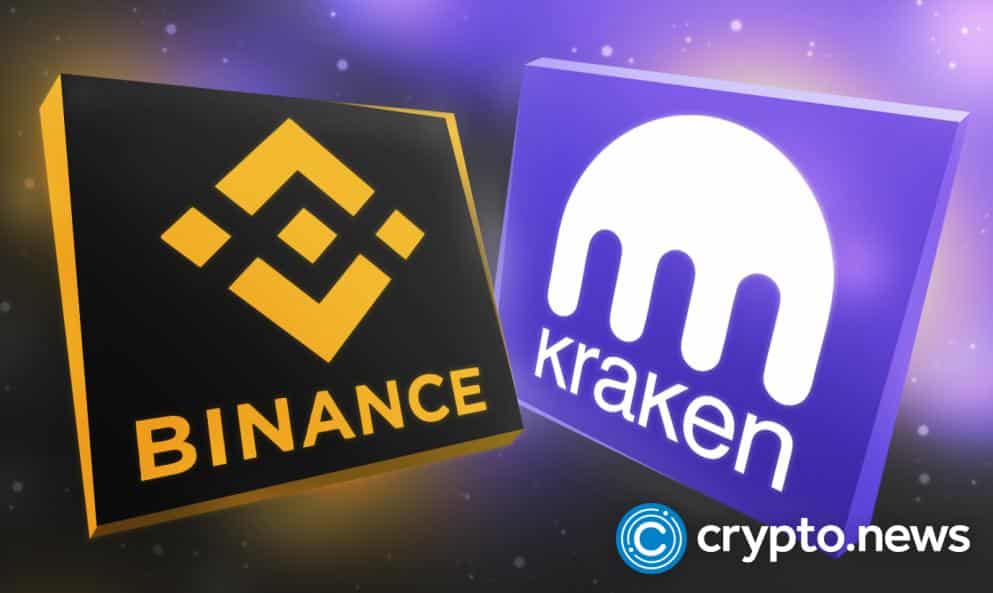Binance vs. Kraken: Which Is Better to Trade and Grow Crypto Holdings On?

Binance is the world’s largest and leading cryptocurrency exchange. It handles over $75 billion daily. On the other hand, Kraken is one of the oldest Bitcoin exchanges and supports over 120 coins. Kraken is one of the exchanges that charge reasonable trading fees for each of its trading options. Kraken and Binance are two well-known cryptocurrency trading platforms with millions of users. Kraken is ranked fourth by volume, whereas Binance holds the top spot.
More About Crypto Exchanges
Cryptocurrency exchanges are an essential component of the trade among all levels of traders, including crypto whales and novices. Cryptocurrencies exist as digital assets and are traded in a similar way to most assets. That means they require a marketplace to buy and sell them safely though they can be exchanged hands through P2P transactions. These trading gaps are where crypto exchanges come to fill in.
Cryptocurrency exchanges are one of the most crucial components of the crypto market. They facilitate the smooth running of the crypto space by ensuring that trading remains active at all times. The market would be considerably more challenging to navigate without them.
When picking a cryptocurrency exchange, there are a few things to consider. Security is the first thing to consider. Make sure the firm uses two-factor authentication and has a good reputation. The cost of using an exchange is another factor to consider. The third is user-friendliness. You want an exchange that is simple to use and understand. The most crucial thing is to find one that meets your demands and that you’re comfortable with.
With the exception of crypto-based equities just getting started, most cryptocurrencies are not available for trading on a traditional exchange. As a result, you need a cryptocurrency exchange. There are a few different sorts of exchanges, each with its own set of benefits and drawbacks. The most common types of crypto exchanges are centralized, decentralized, and hybrid.
A centralized crypto exchange (CEX) is a platform where cryptos are purchased and sold using the help of order books to execute these transactions. They have centralized power hierarchies. In contrast, Decentralized exchanges (DEXs) are more in line with the spirit of cryptocurrency. Investors on DEXs can directly interact with one another without the need for a middleman. The smooth running of the transactions is only monitored algorithmically through AMMs and liquidity pools.
Hybrid exchanges are the rarest of all. They’re designed to take advantage of both CEXs and DEXs while minimizing their drawbacks.
Binance and Kraken are both CEXs well-known in the crypto community. Unlike Coinbase, Kraken and Binance are more suited to investors with some trading experience. Both platforms have low fees, support for customers and institutions, and advanced trading interfaces for experts. However, they differ in terms of pricing structure, crypto choices, and account features.
Most investors are perplexed about which exchange to use because of their nearly identical levels of user services. If you’re among them, worry not any longer. Continue reading and discover which exchange is best for you.
Company Overview
Kraken is a well-known cryptocurrency exchange founded in 2011 in San Francisco and has offices worldwide. It serves clients from all over the world, including the United States. Kraken offers competitively priced bitcoin trading to both individual and institutional investors.
This exchange was founded in 2011 and began offering trading services in 2013. It is owned by Payward Inc. and led by CEO and co-founder Jesse Powell. Kraken is a feature-rich trading platform for individual cryptocurrency enthusiasts and large traders. It offers a variety of account types to meet the needs of different traders and investors.
Binance is a decentralized crypto exchange that was initially based in China. It was founded in 2017 by software developer Changpeng Zhao. The Chinese-Canadian coder honed his skills by building high-frequency trading systems for Wall Street’s flash boys.
Binance started with headquarters in China. However, it was later moved to Malta because of regulatory concerns. It has gone up and down over the years, becoming one of the most coveted cryptocurrency exchanges. For worldwide customers, Binance provides over 600 cryptoassets. However, it’s worth noting that the worldwide Binance platform differs significantly from its U.S. counterpart. Binance.US only offers 65+ cryptocurrencies.
The main Kraken platform is ideal for beginners. However, expert and advanced cryptocurrency users may choose to use Kraken Pro and the more sophisticated margin and crypto futures tools. On the other hand, experienced traders will appreciate Binance’s diversity. However, many users may be confused by the numerous characteristics of this platform. Furthermore, its ongoing investigations and the increasing number of regulatory concerns are unsettling.
Binance vs. Coinbase Summary
Below is how the two exchanges fair in a tabulated format
| Feature/ Service | Binance | Kraken |
| Fees | 0.02% to 0.10% purchase and trading fees .3% to 4.5% for debit card purchases. Free Single Euro Payments Area (SEPA) transfer or $15 per U.S. wire transfer | 0% to 0.26% per trade. 3.75% + $0.205 for credit card purchases. 0.5% for online banking processing |
| Supported Assets | Over 600 supported crypto assets. | Over 110 crypto assets. |
| Security Features | 2FA Verification Protocols FDIC-insured USD balances for the Binance.US subsidiary. Device management. Address allows listing. Cold storage for the majority of the crypto-assets. Biometric security measures for mobile applications. | 2FA withdrawal email confirmation. Air-gapped cold storage. and strict surveillance. Precise API key permission control. SSL encryption. Biometric security measures for mobile applications. |
| Wallet | N/A | N/A |
| Supported Transactions | Limit order Market order Stop-limit order Trailing stop order Post only order Peer-to-peer trading Margin trading One-cancels-the-other order Take profit order Buy order Sell order Receive order Convert order And much more | Buy order Sell order Send Order Receive order exchange crypto margin trading Limit order market order stop-loss limit order stop-loss market order Futures trading take profit market order And more |
| Maximum Daily Trading Amount | Limits differ based on the cryptocurrency purchased | $100,000 minimum order limit for Kraken OTC desk |
| Mobile App | iOS and Android | iOS and Android |
| Bank Account Fees | Free outside of the U.S. | $4 to $35 |
| Trades | 0% to 0.1% maker-taker fees based on rolling 30-day volume and BNB holdings | 0% to 0.05% maker-taker fees based on rolling 30-day volume |
| Offer /Bonuses | $9 sign-up bonus for new users. Earn $20 for referrals. Binance offers seasonal trading competitions and other events across different trading. The options include derivatives and margin trading. | Earn payout of up to 20% of fees collected from a client you refer (for the lifetime of the client) up to $1,000.Trading fee calculations include spot trade fees, margin opening fees, and margin rollover fees. |
| Passive Earning Methods | Earn passive income by using Flexible and Locked Savings. Binance’s protocols such as ETH 2.0 staking, Binance Vault, DeFi staking, and the Binance Launchpad. | Kraken offers both on-chain and off-chain staking. Staking for 13 assets rewards up to 20% for certain crypto. on-chain assets have no minimum staking time requirement, and a twice-per-week payout rate applies to every asset |
Key Features
Supported Currencies
Kraken cryptocurrency exchange allows traders to trade more than 110 cryptocurrencies, including three stablecoins: USD Coin (USDC), DAI (DAI), and Tether (USDT). It accepts seven fiat currencies, including USD, EUR, CAD, AUD, GBP, CHF, and JPY. U.S. investors are limited to 52 coins. Moreover, note that not all crypto coins are available in every country.
Binance supports over 600 cryptocurrencies and 150 trading pairs. Its U.S. entity, the Binance.US, offers about 90 crypto assets only. In addition, it accepts 19 fiat currencies, including USD, AUD, HKD, EUR, GBP, and INR. Binance also supports over 18 different fiat currencies for deposits and withdrawals.
Both crypto exchanges have more than 100 trading options. They also support notable cryptocurrencies such as Ether (ETH), Cardano (ADA), Litecoin (LTC), Chainlink (LINK), and Monero (XMR), among others. Kraken is the only one to deal with Polkadot (DOT) for U.S. citizens.
Trading Fees
Kraken and Binance both use the maker-taker fee structure. They provide significantly cheaper pricing than other well-known platforms such as Coinbase. On the surface, Kraken’s costs appear greater than Binance’s. When compared to Binance, Kraken’s maker-taker fees range from 0% to 0.26%, whereas Binance’s range from 0% to 0.10%.
On Kraken, a new trader with a low trading volume would pay a maker fee of 0.16% and a taker fee of 0.26%. The same investor would pay a maker fee or taker fee of 0.10% on Binance. However, using Binance Coin (BNB) to pay your fees comes with a 25% fee discount. Additionally, having more Binance Coin lowers your transaction costs.
With that in mind, Kraken’s cost plan is simple to comprehend, whereas Binance’s is more complicated and depends on VIP status. Note that fees for Kraken Pro may be different. You’ll need to check the official Kraken fee schedule if necessary due to constant adjustments.
Regulatory Compliance and Controversies
Both Binance and Kraken have had to deal with regulatory difficulties in the cryptocurrency sector. Binance has had a challenging year as of late, owing to regulatory concerns. Several nations, including the United States and the United Kingdom, presently have limits on Binance. These allegations concern insider trading, money laundering, and breaches of other regulations.
In addition, several European nations, as well as Asia countries like Japan, Malaysia, and Thailand, have publicly slammed the crypto exchange. One of the several concerns regulators have with Binance is its global headquarters’ obscurity.
Kraken has not been immune to regulatory trouble. In its statement, the FCA referred to Kraken as “scammers.” Additionally, Kraken was fined $1.25 million after being accused of illegally allowing U.S. residents to trade margin products connected to Bitcoin and other virtual currencies.
From June 2020 to July 2021, Kraken permitted transactions normally prohibited to U.S. traders. The exchange also neglected registering as a futures commission merchant, which is against the law.
Passive Earning Methods
Binance and Kraken have methods of earning money in the cryptocurrency sector without having to trade constantly. One can earn passive income in Binance by using Flexible and Locked Savings. More features are available through Binance’s protocols. These protocols include ETH 2.0 staking, Binance Vault, locked savings, DeFi staking, and the Binance Launchpad.
On its platform, Kraken offers both on-chain and off-chain staking. The rewards earned from staking euros, dollars, and bitcoin are generated by Kraken’s internal algorithms rather than through on-chain protocol staking. On the Kraken platform, twelve different crypto assets can be staked to earn returns. On Kraken, Kava is the crypto-asset with the highest yearly Pos return of 20%.
Security and Insurance
Although both platforms adhere to the strict Know Your Customer (KYC) requirements worldwide, they take security differently. Binance, for example, does not devote any space to detailing its security procedures. In contrast, Kraken stands out for its security precautions and efforts to enhance industry-wide security.
Both platforms offer two-factor authentication (2FA) and other typical security features. However, Kraken distinguishes itself from the competition by its commitment to openness and security in the cryptocurrency sector. When creating an account on Kraken, you must submit personal information, such as your name, address, phone number, and Social Security number. The procedure is designed to cover the broader KYC spectrum.
Binance uses two-factor authentication via the Google Authenticator app or SMS, address whitelisting, device management, and restricted device access as security safeguards. FDIC insurance is available on all U.S. dollar balances through the Binance.us platform.
Also, keep in mind that Kraken has been operational since 2013 and hasn’t been hacked. However, Kraken and Binance have both been subjected to distributed denial-of-service (DDoS) attacks over the years.
Trading Experience
Both platforms provide features suited for both novice and expert traders, although Kraken is superior for U.S. customers. Binance is preferable due to lower costs and advanced trading functionality. The Kraken Pro trading platform and account manager assistance are available to more experienced traders.
There are several trading services and platforms for professional traders and institutions. The OTC Desk by Kraken, for example, has a $100,000 minimum order quantity limit. It also provides top market insights, high-volume trading, and one-on-one assistance to corporations and high-net-worth individuals.
Binance also offers institutions several alternatives. However, unlike Kraken, Binance permits the trade of hundreds of different cryptocurrencies. This makes it a much better choice for those who want more coins and tokens to choose from.
On the trading side, you can use peer-to-peer transactions, the Classic Binance trading interface, the sophisticated platform, and Binance’s OTC trading portal. In terms of simplicity of use, it’s clear that Binance offers a superior & smoother user experience than Kraken.
Both platforms have a steep learning curve for newcomers. On the other hand, Kraken has a wealth of knowledge materials, including crypto instructions and videos. They’re also more receptive to customer service queries than Binance.
The Binance user interface is more cluttered than that of Kraken, and the Binance.US platform lacks direction for newcomers regarding investing. They’re also less transparent about costs and security than other exchanges, so that beginners may be better off with a simpler one with fewer features, like Coinbase.
Which Exchange Is Better to Trade On?
Binance and Kraken are both excellent crypto exchanges. However, they have significant flaws that may prevent their customers from profiting. Binance is not available in several countries, including the United States. Because they profit from distinct advantages, an investor can employ both simultaneously rather than choosing just one.
However, the major disparities in access are caused by the exchanges themselves. Anyone can use the Kraken exchange; although U.S. users have fewer alternatives than foreign customers, the differences aren’t as apparent.
Both crypto exchanges provide traders with sophisticated trading tools, low costs, and instructional materials. With Binance, international customers can trade in a variety of cryptocurrencies. However, fewer alternatives will disappoint U.S. customers. Kraken offers greater transparency, prioritizing security, and a decent number of currencies for U.S. consumers, but it does so in comparison to Binance’s offerings.
There is a third alternative, which is to utilize both at once. Traders who take advantage of two exchanges might make their trading activities more lucrative. Also, be sure to DYOR before utilizing either exchange since their rules are subject to change without notice.
Final Word
Kraken and Binance are similar in several aspects, yet some distinctions exist. They’ve both proven successful over time, making them the first choice cryptocurrency trading platforms for many individuals. However, they also have certain drawbacks, and they also complement each other in some instances.
The value for money of a cryptocurrency exchange is one of the most crucial aspects to consider when selecting one. Binance has a higher value for money score than Kraken in this case. It’s also important to examine how many active users there are. Clearly, if you compare Binance vs. Kraken, Binance boasts a more extensive active user base.
Fees, asset selection, legal concerns, trading possibilities, and innovation are all examples of issues that one should focus on while selecting a crypto exchange. If you go wrong on an exchange and its operations fail, you could lose your funds or suffer other significant inconveniences.
That indicates that investors should begin researching different crypto platforms instead of relying on one as a favorite. Consider the aforementioned criteria while selecting an exchange that is appropriate for you. Also, remember to be cautious about the crypto space as it is still young and subject to fast changes.













